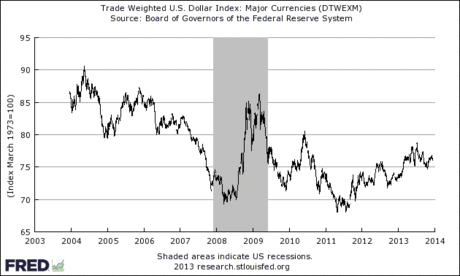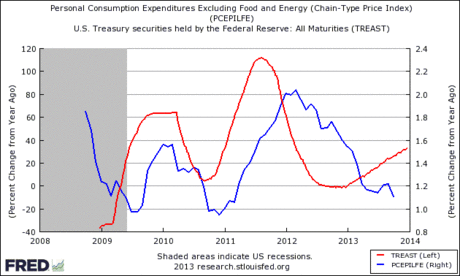Inflation in the US has been drifting lower for more than a year, a trend that confounds and confuses the “hard money” folks. By this point we should have been battling the fallout from high inflation and a debased currency, or so we were told. But a funny thing happened on the way to the future as seen through the eyes of the goldbugs: the forecast imploded. That’s not surprising--lots of predictions have turned out to worthless in recent years. Par for the course. But it’s dangerous to simply assume that the past will continue to be prologue. So what should we expect as 2013 winds down? Let’s start by considering what the numbers show recently.
Let’s begin by recognizing the US dollar has strengthened over the last two years. The idea that the currency was headed for the ash heap of forex history looks foolish at the moment. The trade-weighted measure of the greenback against the major currencies has been trending higher since 2011, and is roughly unchanged from the months preceding the start of the Great Recession. So much for debasement.

Meanwhile, inflation risk continues to look unusually low. The Fed’s preferred measure—personal consumption expenditures less food and energy, aka core PCE—is rising at just over 1% a year lately, or well below the central bank’s 2% target.
So what might alter inflation’s trend and move us closer to the dark fears of the hard money crowd? The sky’s the limit when it comes to possibilities. If you’re looking for colorful narratives on how inflation will threaten these United States, the world is awash in hazardous potential. Reasonable narratives, on the other hand, are another matter. In any case, the future’s still uncertain but one of the more intriguing outlines of what may happen is bound up with how the Fed will reduce its balance sheet in the months and years ahead. It remains to be seen if the reversal of monetary stimulus will be handled smoothly, in which case inflation's inevitable rise will be a relatively low-risk affair. But there's no guarantee. So what should we expect for inflation? On that question, one dismal scientist outlined a framework that’s worthy of attention.
David Beckworth observes that the annual rate of change in the Fed’s holdings of Treasuries lately has a tendency to lead the core inflation by roughly six to nine months, as the chart below shows. Note that the year-over-year rate in Treasury holdings (red line) has been trending higher since late-2012, rising more than 30% recently vs. the same period a year ago. Year-over-year core PCE inflation, however, has yet to react (blue line). But, with recent economic data looking relatively upbeat—including last week’s upward revision in third-quarter GDP--one can only wonder if inflation is poised to trend higher.

It’s getting easier to imagine a world with firmer pricing pressures. But first let’s see what happens with this week’s jobless claims update on Thursday. New filings for unemployment benefits have jumped sharply lately. For now, this warning is the outlier relative to most macro data. But if the dark trend in new claims rolls on, the case for assuming that inflation will perk up will look unconvincing, in part because we should expect the Fed to rethink its tapering program that started last week. One the other hand, if this Thursday’s claims report looks encouraging, maybe inflation is headed higher in 2014 after all.
